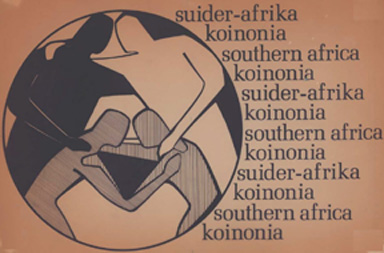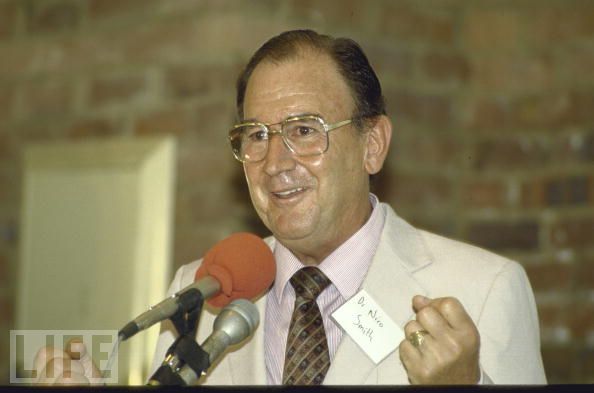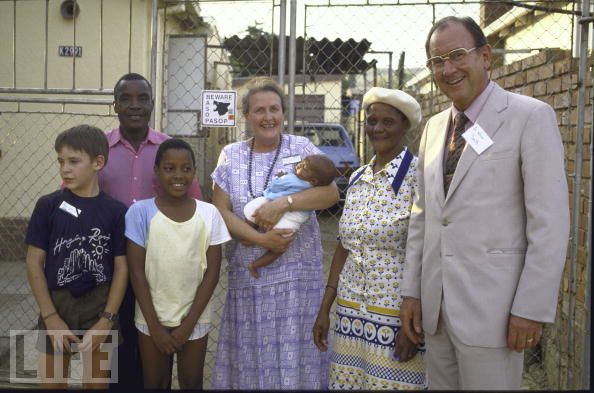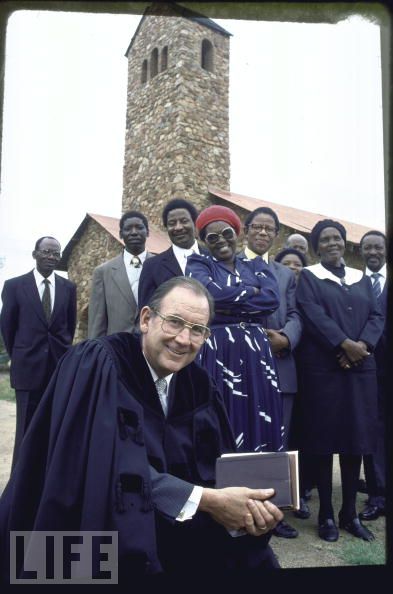Jewish-Palestinian
Living Room Dialogue at sixteen
Remembering our roots in Koinonia Southern Africa
by Libby and Len Traubman
At our 200th meeting on the San Francisco Peninsula, we remembered our birth.
We realized that not only our DNA, but more recent roots in applied social intelligence, came out of Africa.
PREAMBLE: Centuries of engagement, unspeakable gratitude
Monday, December 8, 2008, our 16-year-old Jewish-Palestinian Living Room Dialogue in California gathered in a participant's home for the 200th time.
Our convening reminded us of Convivencia, living together, describing in Spanish the better part of 1,000 years in Spain - Al Andalus - before 1492. During those many centuries, Muslims, Jews, and Christians lived together, matured, and flowered under Muslim rule.
Our start in July, 1992, marked the first San Mateo in-home gathering of a courageous, inquisitive handful of Palestinian, Jewish, and supportive other women and men.
We had been compelled by the June, 1991, Beyond War conference - Building A Common Future - which a few of us had helped conceive and enact in the California redwoods for Israeli and Palestinian citizen-leaders. One result was their historic, first signed document - "Framework for a Public Peace Process" - presented at a Stanford University public ceremony to a standing ovation and reported in print and TV news.
The at-home, face-to-face living room model had come to our attention in 1989, when the annual Beyond War Award was presented to Rev. Ivor Jenkins of Koinonia Southern Africa, as well as to Neve Shalom~Wahat al-Salam (Oasis of Peace) cooperative village of Palestinian and Jewish families sharing their lives in Israel.
Koinonia means "belonging together." During the 1980s years of apartheid, blacks and whites of the Koinonia Southern Africa movement gathered in family residences and public places to share stories and meals, sometimes at risk to their lives. They helped change the fabric of South African culture and the direction of history itself.
Their story and methods changed how we would live our lives, too.
Now, after sixteen years, our California Dialogue continues to pass on the tradition, having helped birth and support many dozens of similar groups in North America and beyond, while initiating hundreds of public outreach endeavors.
We continue providing humankind with best-practices and inspiration, while preserving increasing hundreds of success stories of others in Palestinian- Jewish and interfaith relationship building worldwide.
At year-end 2008 we remember and thank those Muslims, Jews, and Christians of Convivencia; blacks and whites of Koinonia Southern Africa; inventive Americans of Beyond War; visionary Palestinians and Israelis who created the Oasis for Peace, and who forged the "Framework for a Public Peace Process," and all those we name from our personal lives and collective histories - even antiquity - who continue to shape and inspire us.
Today we especially cannot forget our African exemplars of vision and courage.
KOINONIA SOUTHERN AFRICA: Brave citizens, right means, inventing their future
We learn about the Africans
In 1982, in response to the USA-USSR nuclear threat to all humankind, several hundreds of us mostly-California families launched the successful, grassroots Beyond War Movement. It was not an "anti" endeavor, but an intensive search for principles and people to lead the world away from the brink of extinction and beyond war - resolving inevitable conflicts without violence, for the good of all. One of our hundreds of public initiatives was the Beyond War Award, given annually to individuals or groups who made significant contributions to move the world beyond war.
In 1989, two recipients were Wahat al-Salam - Neve Shalom in Israel, and Koinonia Southern Africa in Pretoria. We were deeply inspired by a 5-minute film of the blacks and whites who shared their personal stories and meals in their homes and in public, often at risk to their lives. From a distance, we could see how - faithful to their means - they deepened their relationships and expanded their numbers across borders to include tens of thousands.
Although apartheid had not yet ended, we perceived that Koinonia's process of change worked and was going somewhere. Right away we began searching our American neighborhood to initiate our own black-white meal-sharing group. At first we encountered fears and "reasons" people declined to participate, and we learned how trust and group-building require time.
Within a year, we found dedicated white and black meal-sharing partners. It worked. We changed.
"Old-fashioned Potlucks Lead to New Friendships" was the half-page 1991 newspaper headline - our newest story on the way to many more.
This was to be our foundational model for successful community building, including with Palestinians and Jews, and universally for all cultures and age groups we were to convene over many years.
The visionary citizen
Historian Pieter L. Moller described Koinonia's founder, Nico Smith, a retired professor from the University of Stellenbosch and University of South Africa, Pretoria.
"Nico Smith, a white academic from Pretoria was in close contact with the black young people of Pretoria, Johannesburg and the Vaal Triangle. In time they had grown to trust him. Nico Smith shocked many people when he, as a white man with an impeccable Afrikaner pedigree, with a prestigious university job and a comfortable home, moved with his wife, Ellen, to the deprived and despised South African township of Mamelodi.
"Although there were many people who felt the same as Nico, none of them had gone as far as living with the blacks and taking it upon themselves to share in the suffering of the township, as far as he did.
"The following was said regarding him by Piet Mabuza, an old evangelist from Mamelodi, in May 1987: 'Dr. Smith is the white swallow and he has come to live with the black swallows beneath the Magaliesberg hills. He has built himself a swallow's nest among the four rooms. He has come to be among us, and to help us to fly free.'"
Also in 1987, Time magazine quoted Smith: "Social pathology is consuming the townships. There is a loss of sensitivity for people's own lives and for the lives of others."
The Rev. Smith compared the situation to that of laboratory animals that begin to devour one another when conditions become unbearable.
What changed the person
For 20 years, this same pastor and theologian defended the system of apartheid while preaching in an all-white church and teaching at the university.
Father Luke Veronis recorded his interview of Smith.
"One day in the 1960s, the theologian Karl Barth asked Nico a challenging question. 'Are you free?' When Nico confidently responded that they have religious freedom in South Africa, Barth interrupted, 'No no no. I mean are you free - free to live and preach the Gospel, even if your family and friends, and society itself, stand against you? Are you truly free?'
"Like a young self-assured man, Nico thought that he was free. But as the years passed, this question kept haunting him. 'Am I free to honestly live and preach the Gospel?'
Father Veronis wrote: "By 1974, Nico finally came to the realization that he wasn't free. He started to see that the Bible didn't teach apartheid, and thus, he could no longer accept this unjust system. Uncertain about his future, yet sure about his newfound beliefs, he began to take a confrontational stance against apartheid, preaching a message of reconciliation for whites and blacks.
"His parishioners, students, the university administrators, and even his family and friends began seeing his message as a threat to their way of life, and a danger to the overall establishment."
"By 1981, he was forced to resign from the university, and asked to leave his Church."
In 1982, newly understanding their faith and destiny, Nico and his wife became the first white people to move into a black township, where he began to pastor an all-black congregation.
Smith's extended family thought that he had gone mad, and his former church condemned him as a traitor. The government attacked him as a communist, and the secret police tapped his phone, keeping constant surveillance on him, harassing and threatening him and his family.
Mobilizing for authentic peace
Gidron, Katz, Yeheskel Hasenfeld, co-editors of "In Mobilizing For Peace," described the creative minority promoting face-to-face contact to transform personal attitudes about race.
"Following the precepts of the "contact hypothesis," these organizations focused on arranging "encounters." Koinonia, SAIRR, Black Sash, and Idasa were at the forefront of such work.
"At the launch of Koinonia ("belonging together") in 1986, Nico Smith, the founding national director, stated that the organization's aim was 'to promote contact between people of different race groups in a polarized South African society.'
"Koinonia assessed the South African situation as "a conflict of the unknown," where whites did not know blacks, and vice versa, and from 1988 onwards it organized "encounters" with around three hundred people at a time in various townships.
"Koinonia also arranged informal meal groups in people's homes, group trips to restaurants and cinemas, and joint community projects."
The first participants
Historian Moller described beginnings.
"'Koinonia' means fellowship. It's a word used to express the spirit of generous sharing as opposed to the spirit of selfish getting.
"The people of Koinonia actually do a most basic thing. They eat together. True get-togethers are only possible when people regard each other as equals. This is one of the basic problems in South Africa. Horizontal relationships did not exist between whites and blacks.
"Nico Smith started off by identifying seventeen people who were willing to participate in an experiment of reconciliation by sharing meals together in their individual homes. The seventeen people, equally divided between blacks and whites participated. And this was where 'Koinonia' was born.
"The plan of 'Koinonia', was that couples should be divided into groups of four, and that once a month they should take it in turns to eat at one another's homes, alternating between the township and the white suburbs.
"For blacks, as well as whites, the first meal had been a very emotional time.
Black, white citizens embrace Koinonia, each other
Within three years, Koinonia had spread nation-wide and was to attract international attention.
Even earlier, in 1988, a New York Times article already headlined: "Mamelodi Journal; Behold the Dream! South Africa Without Racism."
"Jackson and Maria Mbetha had never before been hosts to a white family in their modest but neat home in this black township outside Pretoria.
"But last week Alexander and Gillian Venter moved in with the Mbethas for five days, and the encounter transcended the usual barriers of this rigidly segregated society.
"'It has been a very important experience for us,' said Mr. Mbetha, who works as a messenger for a white dentist in Pretoria, about a 25-minute drive away. 'We can see now that whites are just like every black man.'
"Mr. Venter, a lay preacher of Dutch descent. agreed. 'It has made me realize more deeply that what blacks want is exactly what we want: a comfortable home, food, water and an education for our children,' he said. The Mbethas and Venters were among some 200 Christians who crossed the racial divide from both directions in an experiment that created, however fleetingly, a microcosm of a nonracial South Africa.
"The exchange was at the heart of an interdenominational conference organized by Koinonia Southern Africa, a national Christian organization that is trying to bring about racial reconciliation. About 170 whites moved in with black families in Mamelodi and 35 blacks stayed in white homes in the relatively affluent suburbs of Pretoria.
The whites who crossed the racial barrier came from a range of social and economic backgrounds in both Afrikaans- and English-speaking communities, though as professing Christians all were prepared to try to look at life from the other side."
"They lived together, prayed together, socialized together. . .On Saturday night the 200 participants got together at a barbecue at a church center in the township.
"'People in the townships who have seen the whites living among us see it as a sign that the Government will not be able to continue enforcing apartheid,'' Mr. Mbetha said.
People, then history, changed
In only a few years, Koinonia connected and changed tens of thousands of South Africans, along with other citizen-to-citizen endeavors.
By 1994, the nation's social and political fabric matured.
Nelson Mandela was elected South Africa's first black President, in that country's first truly democratic election.
Incorrectly believing that this singular political step was adequate in the long process of social change, Koinonia participants discontinued their activity after the election.
Many South Africans, then and now, see that this successful relationship-building activity is forever needed on the long road to true authentic, sustainable community that insists on heart-to-heart connection, excellent communication, and unprecedented cooperation and creativity that benefits all.
Today in 2008, with more passion and eloquence than ever, 80-year-old Nico Smith agrees with all his great mind, heart, and soul.
Equally, Nico speaks of effusive gratitude that the tradition of sustained Dialogue championed by Koinonia Southern Africa is increasingly practiced across oceans and around Earth.
BIBLIOGRAPHY
|
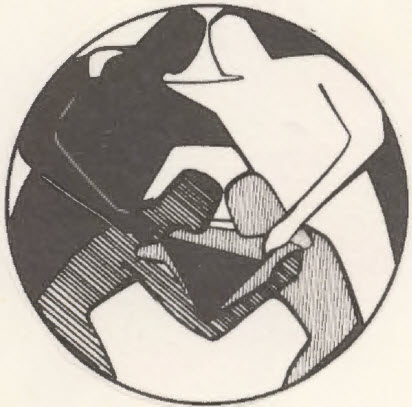
|
Behold the Dream! South Africa Without Racism (Mamelodi Journal)
by John D. Battersby
Published in the New York Times - 21 March 1988
http://query.nytimes.com/gst/fullpage.html?res=940DE6D9173EF932A15750C0A96E948260&partner=rssnyt&emc=rss
Beyond War Award (1989)
Koinonia Southern Africa video (5 mins)
http://www.youtube.com/watch?v=7iomC0jDF_c
and
1989 Beyond War Award (59 mins)
http://traubman.igc.org/bwaward.htm
Beyond War Movement (1982-1991)
Foundation for Global Community
http://globalcommunity.org/about_us/history.shtml
Faith and Race in South Africa:
The Rev. Nico Smith and his Wife are First Whites to Live Legally in a Black Township
The Christian Science Monitor - 04 January 1989
http://www.csmonitor.com/1989/0104/psmith.html
Koinonia Collection
Index of extenaive archival documentation
Library of the University of the Witwatersrand, Johannesburg, South Africa
http://www.historicalpapers.wits.ac.za/?inventory/U/collections&c=AG3215/I/8711
The Koinonia Concept
Archival document defining principles, strategies, and staff
Library of the University of the Witwatersrand, Johannesburg, South Africa
http://traubman.igc.org/koinoniaconcept.pdf
The Ministry of Reconciliation
by Fr. Luke Veronis
Published by In Communion - Spring 2005
http://www.incommunion.org/2005/01/17/the-ministry-of-reconciliation/
In Mobilizing For Peace:
Conflict Resolution in Northern Ireland, Israel/Palestine, and South Africa
Edited by Benjamin Gidron, Stanley N. Katz, Yeheskel Hasenfeld
Oxford University Press, USA (June 28, 2002), p. 75
Mr. Smith Takes a Black Parish:
White Afrikaner clergy confront South Africa's apartheid
TIME - Monday, 26 July 1982
http://www.time.com/time/magazine/article/0,9171,922966,00.html
Nico Smith
South African minister and activist
in Encyclopedia Britannica
http://en.wikipedia.org/wiki/Nico_Smith
Nico Smith
in Wikipedia
http://en.wikipedia.org/wiki/Nico_Smith
Nico Smith telephone message to the Jewish-Palestinian Living Room Dialogue
Monday, December 8, 2008 - 6 min. MP3 file (6 MB)
http://traubman.igc.org/koinonia.mp3
Old-fashioned Potlucks Lead to New Friendships
Published by The Times, San Mateo, California - March 29, 1991
http://traubman.igc.org/koinonia.htm
South Africa Fellowship Amid Turmoil
By David Brand and Peter Hawthorne/Mamelodi
TIME - Monday, 28 March 1988
http://www.time.com/time/magazine/article/0,9171,967105,00.html
South Africa The War of Blacks Against Blacks
by John Greenwald, Peter Hawthorne and Bruce W. Nelan/Johannesburg
TIME - Monday, January 26, 1987
http://time.com/time/magazine/article/0,9171,963332,00.html
They Also Served:
Ordinary South African Women in an extraordinary South African Struggle
by Dr. Pieter L. Möller
Senior Lecturer, School for Basic Science, Department History
Vaal Triangle Campus, North-West University, South Africa
January, 2006, 7 pp.
FOTIM Gender Studies Conference, 17 to 19 January 2006
http://www.fotim.ac.za/fotim_conferences/genderconf/papers/moller_paper.pdf
White Among Blacks
By Otto Friedrich and Peter Hawthorne/Mamelodi
TIME - Monday, 27 June 1988
http://timeinc8-sd11.websys.aol.com/time/magazine/article/0,9171,967792,00.html
OBITUARY
Jewish-Palestinian Living Room Dialogue Group
1448 Cedarwood Drive, San Mateo, CA 94403
Voice: (650) 574-8303 o Fax:(650) 573-1217
Web: http://traubman.igc.org/
E-mail:LTRAUBMAN@igc.org
